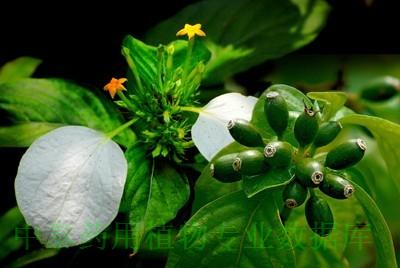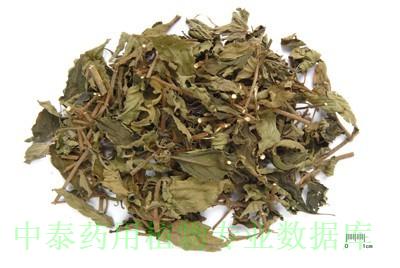| [English Name] | Buddha's Lamp Stem | |
| [Chinese Name] | 玉叶金花 | |
| [Pinying Name] | Yuyejinhua | |
| [Latin Name] | Caulis Mussaendae Pubescentis | |
| [Genera] | Rubiaceae | |
| [Efficacy] | Antipyretic drug | |
| [Pictures] | Plant picture | Drug picture |

|

|
|
| [Alias] | Shangancao, Baicha, Shengjiteng, Zhanqueteng, Tugancao, Liangteng, Huangfengteng, Baitougong | |
| [Source] | This crude drug is the stem with leaves of Mussaenda pubescens Ait. f. (family: Rubiaceae). |
|
| [Plant morphology] | ||
| [Distribution] | This species is distributed in Fujian, Guangdong, Hong Kong, Guangxi, Hainan, Sichuan, Jiangxi, Hunan and Zhejiang in China. |
|
| [Gathering and processing] | The stem can be gathered all year round. After collected, it is cut into segments and dried in the sun. |
|
| [Characteristics] | ||
| [Ecology] | It grows in shade hillside、valleys、stream side and bushes. | |
| [Chemical composition] | ||
| [Pharmacological activities] |
Antifertility effect: Seven compounds were isolated from Mussaendapubescens Ait. f., a Rubiaceae plant, which is used in folk medicine as anabortifacient. According to spectral data and chemical analysis, they wereidentified as β-sitosterol(I); doursterol(II); ursolic acid (III); caffeic acid(IV); p-ooumarlic acid(V); ferulic acid (VI); and shanzhiside methyl ester(VII) respectively.Among them, (IV) and (VI) were shown to terminate earlypregnancy (1 to 2 days) in mice following subcutaneous administration of250mg/kg (IV) and 125mg/kg(VI) [1]. |
|
| [Clinical trial] | Pyelonephritis: Patients were treated with Shenyanan capsule(consist of Yuyejinhua, Juechuan, Yimigen, etc), three are four times a day, 1~2 capsule for each time. Lot of clinic research have proved that the effective rate was 91.5% for the treatment of acute nephritis, 84.6% for acute pyelonephritis, 71.9% for chronic nephritis and 77.8%for urinary tract infection[1]. |
|
| [Properties] | ||
| [Medical and other Uses] | ||
| [Dosage] | ||
| [Cautions] | ||
| [Traditional usage] |
1. Maglignant sores and pyogenic infections 2. Burns, scalds and snake bites 3. To prevent sunstroke and measles 4. Swelling and pain in throat 5. Bronchitis 6. Diarrhea due to latent summer-heat 7. Dysuria due to heat-dampness |
|
| [Toxicological studies] | ||
| [Pharmaceutical preparations] | ||
| [References] |
Pharmacology Actions: [1] Xing-kai Liu, Guo-jian Liang, Xiong Cai et al., Mountain licorice chemical composition and anti-fertility activity, Journal of Fudan University (Medical Science), 1986, 13 (4): 273.Clinical trail: [1] Liu Shuyin . Regulate Spleen Treatment and Observation of Effect of Traditional Chinese Medicine in treatment of urinary tract infection .Chinese Archives of Traditional Chinese Medicine,2006,24(5):969 |
|